These Nine Will Change Your Mind – Garden Grasses for the Skeptic
November 23, 2020
A few weeks ago, I introduced you to the garden and told you the history of the old place with its ice-storm-ruined silver maple transformed into the meadow garden that you see today. We looked at the volunteer echinacea still in bloom and the baptisia that you’d never met but had heard about (a nitrogen fixer, yes!). The western meadow sedge was removed last winter. Its spreading rhizomes persist in the crown of the geranium. You saw the green and nodded, “sedges have edges.” When I explained how easily the New Zealand wind grass volunteers could be plucked from the kinnickinnik, easier than the weedy black medic, you let me know that you’d never met a grass you liked. Defensive (ornamental grasses were the foundation of my entry into this work back in the early aughts with Bamboo Mike), I was quick to draw your attention to the charming eyelash seed heads of ‘Blonde Ambition’ blue grama grass. Not all grasses grow weedy in the garden, I insisted. You didn’t seem convinced.
Would you consider a second look?
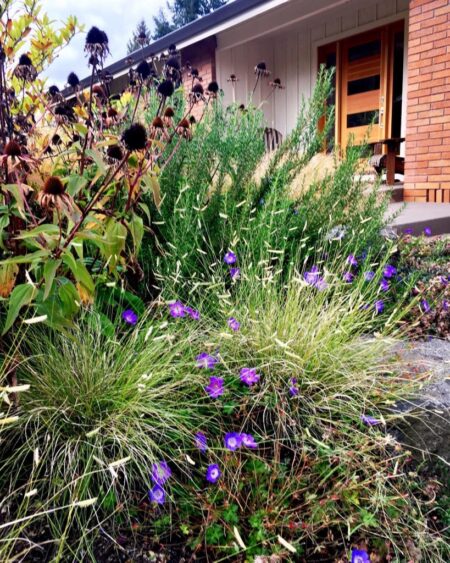
What’s in a grass? Not the musculature of an oak tree’s dark limbs against the blue sky, nor the juiciness of a berry from the bramble thicket. A grass, in spring, can’t confetti the ground in pink like a cherry blossoming nor can it mimic Easter eggs like the closed chalices of tulips. It won’t grow to award-winning weights at the county fair, nor will it host the merry buzz of fat-bodied bumblebees. No pies will be made of it at Thanksgiving, nor lights strung on it through winter.
Grasses begin by greening the remains of their previous season’s death. If you’ve planned your labors with the seasons, you’ve just cut the old away a moment before the new arrives. The fountain grass is a head treated for baldness by the warming light of Spring, bright blades waving youthfully through rain showers.
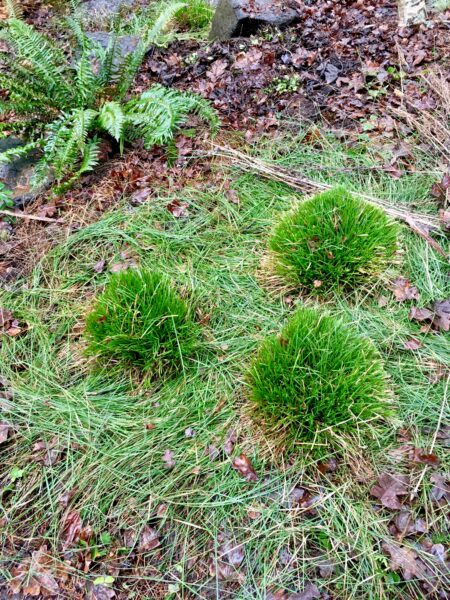
Some garden grasses start early in the year. These relish coolness with names like Deschampsia, Festuca, and Helictrotrichon tripping off your tongue like raindrops in a puddle. Combine them with early bulbs and you’ll see how smart the daffodils shine against the vibrant wellsprings of grass. Isn’t that better than bare ground, or, more likely, a weedy one?
Many other ornamental grasses wait for the warmth of summer to get their green blades flowing and even later to bloom. Chasmanthium, Miscanthus, Panicum, and, in the shade Hakonechloa highlight that time of year when we laze in the hammock and daydream. The wind through their leaves shushes. Warm season grasses shelter ground nesting songbirds and offer seeds. They decorate the view from inside on the first frosty day of November. Seed heads and fall color are worth the wait.
Over the past 20 years, I’ve seen how these beautiful plants, with their light and wind catching qualities, add a naturalism to mixed plantings that can’t be achieved with anything else.
A garden of only flowering perennials is a cottage garden. Mix in some appropriate grasses, and you now have a meadow evocative of a wild landscape, a place for song sparrows to nest, for snakes to hunt, an ecosystem that feeds and shelters the more-than-human residents of the neighborhood.
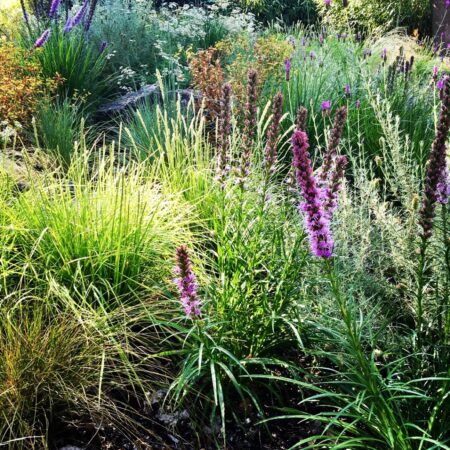
Architectural Grasses
When you think of ornamental grasses, it’s the big all stars that come to mind first – the overused, but reliably vertical feather reed grass (Calamagrostis acutiflora ‘Karl Foerster’), the ginormous pampas grass (Cortaderia sellowiana) that’s become a pest in California, and if you’re paying a bit of attention, you know the bulky maiden silver grass (Miscanthus sinensis) that towers overhead and waits till mid Fall to send out florist’s favorite sprays. These big guys play the role of shrubs in the garden. If you’re looking to add structure, bones, focal points, there’s a grass for that. Nurseries offer a lot to choose from, but some are better than others for the Pacific Northwest.
Here’s some of my favorite architectural grasses for the PNW:
Switch grass (Panicum virgatum) grew in Bamboo Mike’s garden with tulips and calamint. The fast draining soil out River Road was ideal for this species. Too rich and moist would make it flop. The cultivars include bold blue beasts like the 6′ tall ‘Dallas Blues’. I love it’s broader leaves. ‘Shenandoah’ and ‘Rotsrahlbusch’ are streaked red and really light up the garden in Fall. You’ll want to use switch grass as a summer through winter screen to hide a heat pump or your neighbor’s ugly shed. Or plant it individually to bring height dotted through a meadow. It can even play well planted symmetrically as sentinels on either side of a threshold. The tulips in Mike’s garden made the perfect seasonal accompaniment blooming in spring when the grass was short and just emerging from its recent cut back.
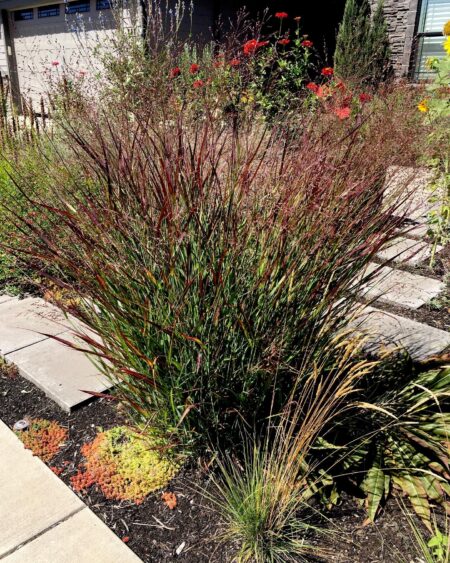
Giant feather grass (Stipa gigantea) is a better big boy than pampas grass any day. It doesn’t cut up your arms like the saw-edged blades of pampas and, if you get volunteers, you’re one lucky bird! A master at catching the light, it’s smartly placed where you’ll view it backlit by the setting sun. With this one, I cut only the flower stalks down in late winter, not the evergreen mound of leaves. Running a leaf rake through it is a satisfying chore to get any dead stuff out, like combing hair. You can trim the long “split ends” while you’re at it. Giant feather grass sends new flower stalks up earlier than a lot of the other big grasses. I’m usually surprised to see them in May making a gold sparkle around the blooming roses. Once established, it’s very drought tolerant. Perfect for the Pacific Northwest.
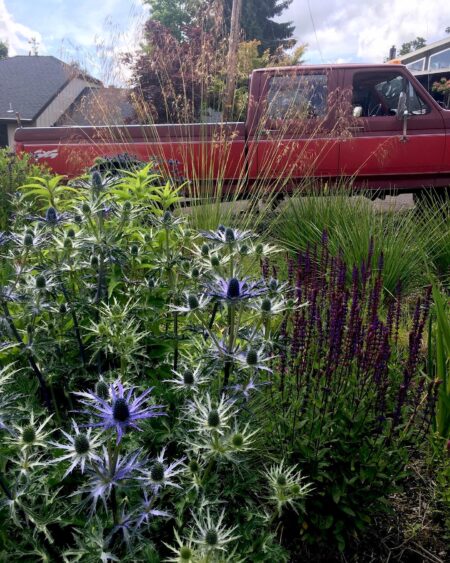
Skyracer moor grass (Molinia caerula ‘Skyracer’) is the last big grass I want to highlight. If your soil is heavy or wet, this is the one for you. A similar cultivar is called ‘Transparent’ and that should tell you a lot about the unique quality of its flowering. Forget about placing the tallest plants in the back. This one dazzles in the middle of the bed offering a magical scrim to view its companions through.
(Sorry I don’t have a great photo of Skyracer, yet. I’ll add one soon. In the meantime, a quick google image search using the botanical name will give you a view of its shimmer and sway.)
Matrix Grasses
Garden grasses aren’t limited to size large. The best actually belong to a second group, those that weave throughout a mixed planting, covering the spaces between and impressing upon the eye a cohesiveness to the scene. Planted singly and in clumping drifts, they’re the warp to the weft of your showier bloomers. You’ll hear them described as “green mulch”, “ground cover” or “matrix” species in ecological horticulture circles. I love the term matrix because it hints at the many relationships between plants in a garden, the layers at work, the network that connects.
For the PNW, the best matrix grasses are:
Autumn Moor Grass (Sesleria autumnalis) is neat with slender spears of flower spikes like a display of 4th of July sparklers for sale. It’s great in any garden. I’ve never seen it look anything but well mannered and charming. Welcome this grass into your perennial flower garden, around shrubs and even in the dappled shade of the orchard or woodland. Known for its chartreuse glow, the leaves emerge in the cool of spring growing to only a foot or so. Summer’s long days bring the sparkling inflorescences up, hovering above the clump of leaves. They continue to look great deep into winter when they ask just one chore from you for the entire year – an easy cut back. Use the trimmings as mulch. They quickly melt into the ground, feeding earthworms and the plants in turn.
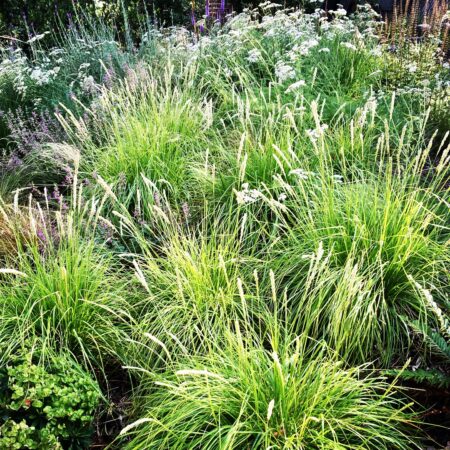
Dense Sedge (Carex densa), a Pacific Northwest native, is the best local green sedge that I’ve found to rival the East Coast favorite Carex pennsylvanica. Dense sedge grows in a clump rather than spreading by underground rhizomes as its Pennsylvania cousin does. This is a big plus in my book. Rhizomatous plants really need to be matched with equally vigorous companions or you end up with a monoculture, and who wants that? An irrigated, fire-resistant planting or a naturally moist area are best for this matrix grass. Let its green fountain create habitat and a calm visual aesthetic. Bulbs like camas and perennials such as checker mallow and lupine add floral color while the overall look is grounded in naturalism.
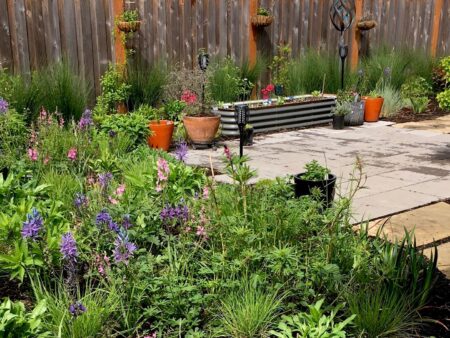
Blonde Ambition blue grama (Bouteloua gracilis ‘Blonde Ambition’) makes me smile. The way the little eyelash seed heads wave in the slightest breeze, catching light as nimbly as air, is captivating. Thriving in hot, dry, open locations, blue grama is the matrix grass for a drought tolerant meadow garden. If you’re replacing a weedy, brown lawn with something better, something for pollinators, something to delight your eyes, weave this grass through it and you’ll have the foundation you need. Stick to the drought tolerant theme with your flowering companions and wha la, you’ve created a plant community! Buzzing bees and foraging birds are sure to join the scene.
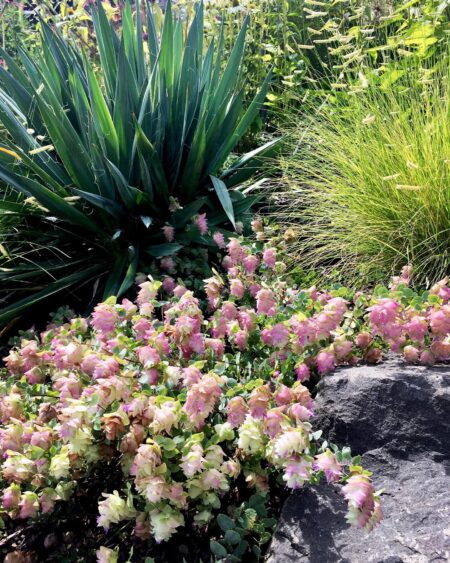
Flowering Grasses
Between the bold architectural grasses and the quiet matrix grasses, shines those whose beauty equals a peony in bloom. I call these “flowering grasses” not because they’re the only ones to flower, but because I mix them into a designed planting as I would any other flowering perennial, using them to highlight a season with the visual power of their distinct bloom. Just as ‘Lemon Queen’ sunflower declares, “It’s high summer, pour some lemonade!”, these grasses mark the cycle of the year with their unique contribution to the beauty of the garden.
Three of finest flowering grasses are:
Pixie Fountain tufted hair grass (Deschampsia cespitosa ‘Pixie Fountain’) is a great example of how a grass can feed us with its beauty while also feeding wildlife. This native attracts birds, the umber skipper butterfly and even bears! Even if you don’t have bears in your neighborhood, you’ll want to include tufted hair grass for it’s hazy autumn glow.‘Pixie Fountain’ is a compact variety just right for planting singly or in great swaths as a lawn alternative meadow garden. I love how its blonde inflorescences combine with blue Geranium ‘Rozanne’ and the dark seedheads of Phlomis russeliana.
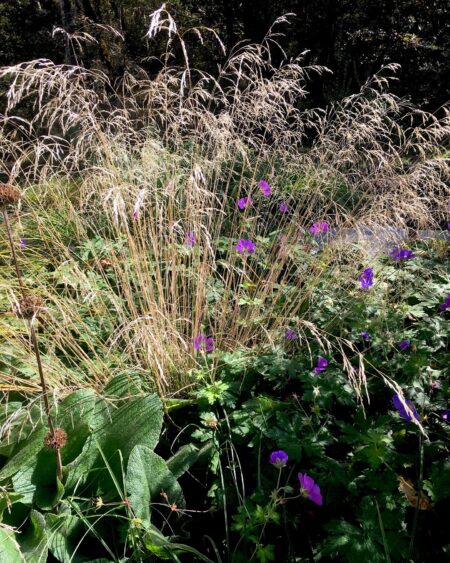
Variegated Moor Grass (Molinia caerulea ‘Variegata’) is the grass I’d include in your garden if you think you don’t like grasses. Its so good looking and well behaved, I know it will change your mind! The tidy clump of soft yellow is clean and bright. When the flowers rise above on light stems, it’s a celebration of the finer things in life – softness and sparkle, joy in a plume. In February or March, when it’s time to cut back any perennials or grasses still standing, you’ll hesitate to cut the still beautiful variegated moor grass. Through deluges and gales, it holds its tawny stems aloft, giving continued structure to the garden all winter long.
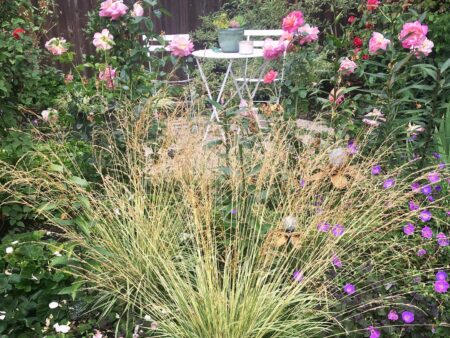
Hameln Fountain Grass (Pennisetum alopecuroides ‘Hameln’) has been around for awhile. A reliable choice for the Pacific Northwest, this fountain grass blooms late after so many other garden flowers have finished. It holds these bottle brush feathers through the fiery coloring of fall and into the muted winter scene. ‘Hameln’s’ fount of green leaves is such a well-kept mound spring into summer that it earns it’s place among the structural or architectural group of plants, too. I use it that way in mixed plantings to create rhythm and order, repetition and pattern.
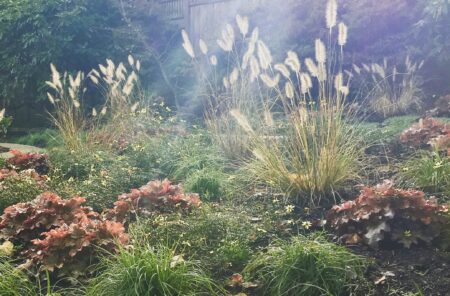
Conclusion
Start with grasses from these three categories. You’ll experience their natural beauty, their low maintenance growth habits and their contribution to feeding and sheltering the more-than-human inhabitants of your yard.
Grasses that are described as “self-seeding”, “short-lived” or “spreading by rhizomes” are best left on the nursery floor. They’ll only reinforce your bias against this group of plants. But, maybe later, you’ll learn how the dynamism of self-seeders can be lightly tended and allowed to add spontaneity to the garden. And how the rhizomatous can be combined with equally aggressive plants to knit together a bank or clothe a distant swath of bare ground.
I hope I’ve smoothed out some of the wrinkles of your skepticism about the poaceous family of grass and their kin the sedges. Do you see how their beauty and habitat function could work in your garden? Tomatoes are fun to grow and so are flowers and shade trees. Why not try your hand at grasses, too?
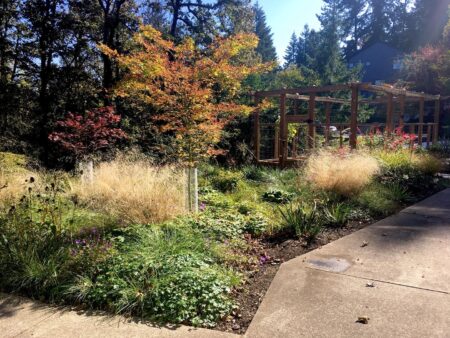
Leave a comment below to tell me which grasses you love or which you might now open your mind to.
